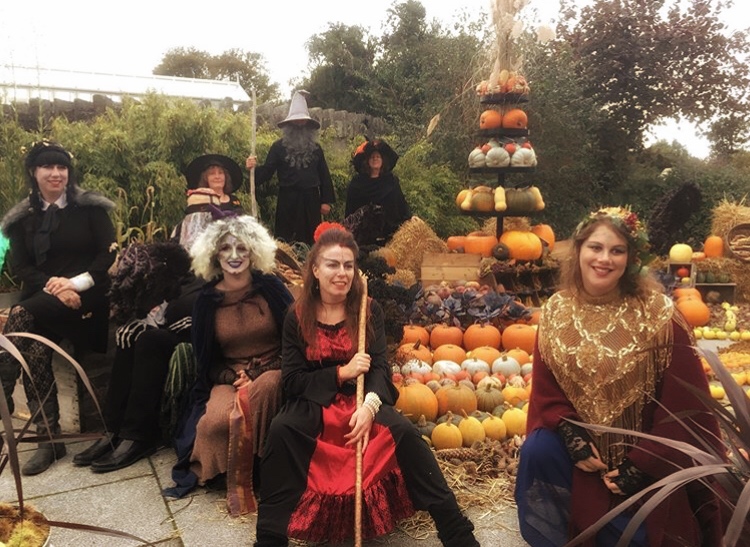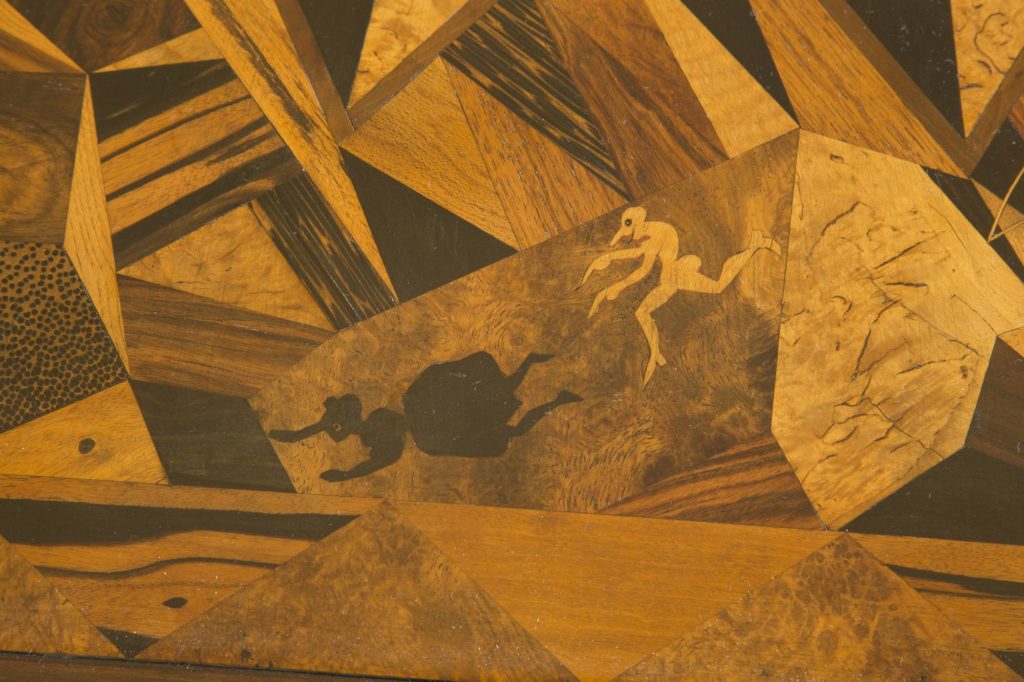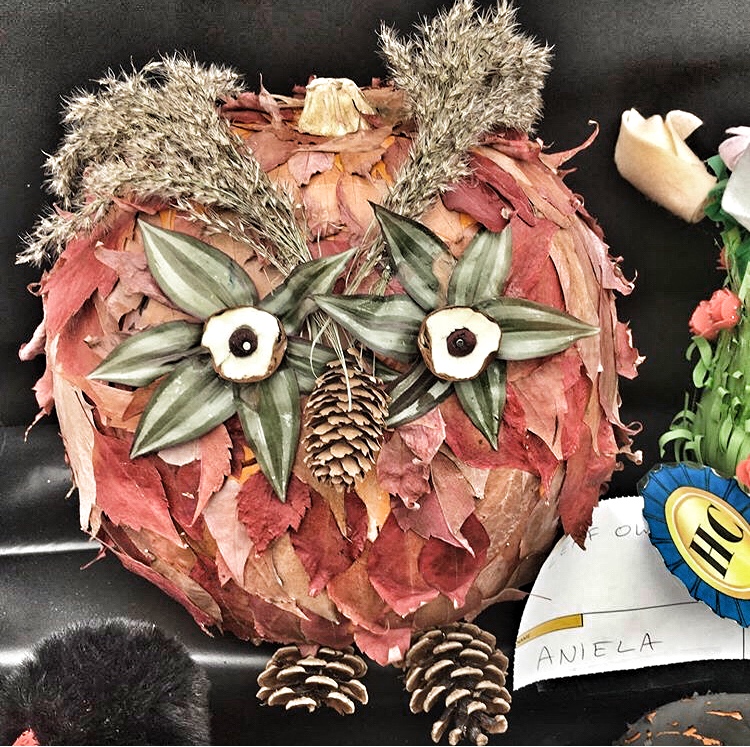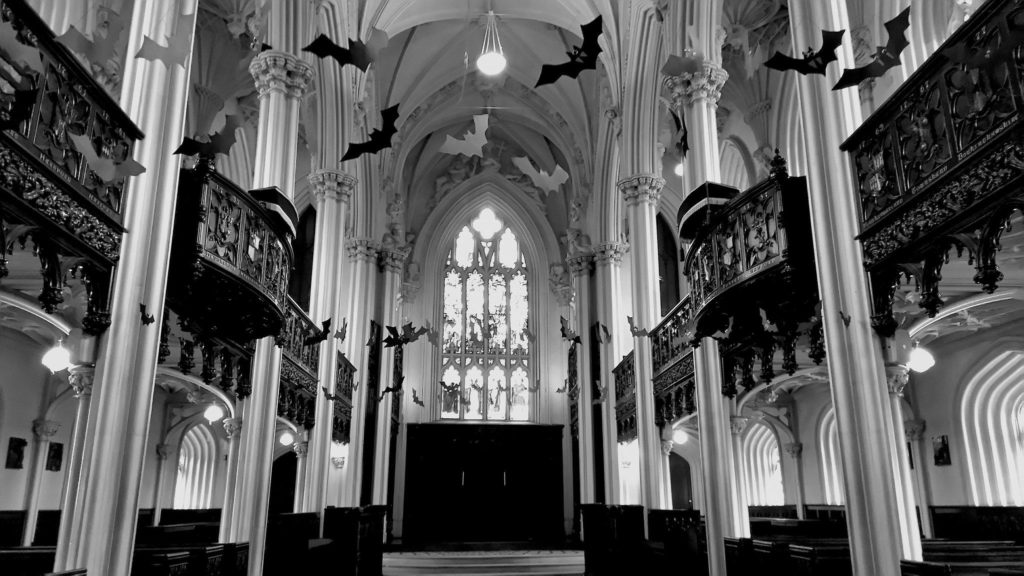By Caoimhe Creed, Guide & Information Officer
Farmers and Druids
Halloween has its roots in the Celtic Festival of Samhain. This was the division between the lighter half of the year and the darker half of the year. Samhain is the Irish word for the month of November. Halloween takes place on the “eve” of November, 31st October, because the Celts believed that night preceded Day. Whereas we count the date from when we wake up in the morning, the Celts counted the date from when the sun set the previous day. So, Samhain began on the night of October 31st.
Samhain was a major harvest festival. As the farmers couldn’t afford to feed all of their livestock for the Winter, this was a time of mass animal slaughter, as well as harvest time for crops. With plenty of fresh meat, fruit, grains and vegetables, Samhain was a time of lavish feasting before the leaner months of Winter.
Samhain was the ancient Celtic equivalent of New Year’s Eve. Samhain did not belong to the old year or the new, and so it was thought to exist outside of time. This meant that the boundary between our world and the spirit world was thinnest and it was the most likely time to encounter a ghost, fairy or god. Many of these were harmful and it was recommended that everyone stay in their homes.
Samhain was the most important of the four quarterly fire festivals – Samhain, Imbolc, Bealtaine and Lughnasa. Bonfires, or “bone fires” (tine chnámh in Irish) were a very important part of the celebrations. A community fire was built, into which the bones of livestock would be thrown. Households would extinguish their own fires, gather together around the bonfire and then relight their own hearths with the flames.
These community fires were a representation of the great fire on the Hill of Tlaghta, now the Hill of Ward, at Newgrange. This was lit by druids to assist the sun on its journey across the sky with the hope that it would return again in Spring.

Guides in Disguise, National Botanic Gardens, 2019
Spirits
Samhain was the easiest time for spirits to visit from the “Otherworld”, but not all of them were malicious. It was also thought to be a time when ancestral ghosts would return to the family home. After the hearth had been relit from the community fire, it was safe for these spirits to enter the home. Food was laid out for them, which was often then given to the needy, although some people believed it was bad luck to eat the food for the dead. Christianity incorporated this aspect of honouring the dead into the Christian Calendar, with All Saints Day on 1st November and All Souls Day on 2nd November.
“Dumb supper” was a domestic tradition that celebrated the dead. A meal was cooked without speaking, and only consumed once the deceased ancestors had been welcomed into the home. Over the meal, the adults would catch the dead up with the news of the year, while the children would sing and perform plays to entertain them.
Halloween was the night that the “fairy hunt”, a group of wild hunters, were known to ride around kidnapping people to take to the Otherworld. One way to avoid them was to wear frightening masks, or disguises. Boundaries were the most dangerous places on Halloween. Spirits were known to manifest at the boundaries between farms, at styles and at the bend of rivers.
The leader of the fairy hunt is called the Dullahan, a headless horseman who rides on Halloween night. He’s known in Irish as the Gan Ceann – literally, The Headless! The Dullahan’s chariot is made up of funeral objects and human remains, and he carries a whip made of a human spine. Wherever he stops, someone is due to die. He can speak only the name of the soul he will reap that night.
A staple of Halloween, or Samhain, was a visit from the Púca. This was an Irish fairy creature, a shapeshifter that often appeared as a hare or a horse. The Púca was an important character in Irish folklore, and farmers would often leave offerings of the first of their harvest, known as the Púca’s share, in the hopes that the fairy would bring them good fortune for the year. On Halloween night, the Púca was known to spit on all the blackberries, making them inedible. This was a deterrent to children, to stop them from eating the fruits out of season.
“Mumming” was the practice of dressing up in costumes and going door to door, performing plays and songs for the dead. “Guisers” were either men or children in disguise. They would be given cakes as payment. These were the “treats”, but it was also a popular night for tricks! “Knick knock” jokes were common, as well as dismantling carts and reassembling them in inconvenient places. This sort of mischief was blamed on the fairies.

The Prisoner’s Table, Dublin Castle
Rituals
Halloween was an ideal time for prophecy, and the brave could be offered a glimpse of the future if certain rituals were performed.
One practice was to stand in the porch of the church at midnight. This would allow you to see the spirits of those who would die in the coming year, but there was always the risk that you would see yourself!
Another ritual performed at midnight was to run around a graveyard three times. This could offer a vision of the future, but also ran the risk of conjuring the Devil.
There were many marriage rituals associated with Halloween in Ireland. It was believed if you put a sprig of yarrow under your pillow, you would dream of a lover. Putting objects such as apples, cabbages, spade heads or spinning wheel parts under your pillow was also believed to bring dreams of your future spouse – but how did they sleep?! Common dreams were of the spouse bringing water or a towel.
Blindfolded games were often used on Halloween to determine the size and stature of a future husband. One game involved selecting a cabbage and its size, shape and roots indicated the qualities of the husband-to-be. He would be rich if a good amount of earth came up with the root, but poor if it came out clean.
There were many charms used to divine a future lover for single women on Halloween. One was to peel an apple in one go, the unbroken peel was then thrown over her shoulder and the shape of the peel determined the first letter of his name.
Another was for her to eat an apple while combing her hair in front of the mirror. At midnight, her future husband would appear over her right shoulder.
If a girl named two nuts, one for herself and one for her sweetheart, and put them on the hob, it was considered a good sign if they jumped off the hob together!
Who knew that Halloween was the most romantic time of the year!
Another ritual for predicting someone’s future at Halloween was to place four bowls on the table with different things in them. A blindfolded participant would choose one to put their hand into.
If they chose the bowl with the water, emigration was in their future. If they chose the bowl with the ring, they would be married that year. If they chose the bowl with food in it, they had a prosperous future to look forward to, but if they chose the bowl with earth in it, it indicated a death in the family.
A similar ritual that is performed even now was that of the Báirín Breac, or Barm Brack (many spellings accepted!).
The báirín breac was the traditional cake eaten at Halloween. Whoever receives the lucky slice with the ring is destined to be the next to marry. However, other items to predict the future were sometimes put in the cake, too. These included a thimble (spinsterhood), a button (bachelorhood), a stick (a fight), a rag (poverty), a coin (wealth) and a crucifix (the taking up of religious orders).
Traditional Halloween food varies from place to place and from family to family, but potato dishes such as colcannon (mashed potato with kale or cabbage) or champ (mashed potato with scallions) were very common. In some places, it was a tradition to place the first and last spoonful of colcannon into a single girl’s stocking. The stocking was nailed to the door, and the next man to walk through the door was the man she would marry.
Stories and Superstitions
In the National Museum of Country Life in Westport, they have a carved turnip, or “ghost turnip”. This old Irish tradition of carving turnips into scary lanterns led to the American carved pumpkins. The origin lies in Irish folklore.
A man called Stingy Jack invited the Devil for a drink and convinced him to shape-shift into a coin to pay with. When the Devil obliged, Jack decided he wanted the coin for other purposes and kept it in his pocket alongside a small silver cross to prevent it from turning back into the Devil.
Jack eventually freed the Devil under the condition that he wouldn’t bother Jack for one year and that he wouldn’t claim Jack’s soul once he died. The next year, Jack tricked the Devil once more by convincing him to climb up a tree to fetch a piece of fruit. When he was up in the tree, Jack carved a cross into the trunk so that the Devil couldn’t come down until he swore he wouldn’t bother Jack for another ten years.
When Jack died, God wouldn’t allow him into Heaven and the Devil wouldn’t allow him into Hell. He was instead sent into the eternal night, with a burning coal inside a carved-out turnip to light his way. He’s been roaming the earth ever since. The Irish began to refer to this spooky figure as “Jack of the lantern”, which then became “Jack O’Lantern”.
People in Ireland and Scotland began to make their own versions of Jack’s lantern by carving grotesque faces onto turnips, mangelwurzels, potatoes and beets, placing them beside their homes to frighten away Stingy Jack and other wandering evil spirits and travellers. Once this became a Halloween tradition, Jack O’Lanterns were used as guides for people dressed in costumes on Samhain. When the Irish emigrated to America, they found that pumpkins were great for carving.

“Leaf Owl” pumpkin, National Botanic Gardens, 2019
The “Lord of the Dead” in Irish mythology was Donn. Donn is the Irish word for brown, the colour of shadows, which indicated the shadowy world of the dead. He was also known as “The Dark One”.
In some stories, Donn was a mortal man, one of the invading Milesians. After insulting the goddesses of the Tuatha Dé Danann, he was shipwrecked and drowned off the coast of Ireland on arrival. As he was the first to die, he was made Lord of the Dead for the new people of Ireland.
Donn’s death is said to have happened at Bull Rock, off Co. Cork. This is where the “House of the Dead” is supposed to be. Those who had died during the year would wander the earth until they heard Donn’s horn on Samhain, calling them to him. The ghosts, or shadows, of the dead would gather at “Tech Duinn”, the “House of Donn”, before moving to the Otherworld.
There are many superstitions in Ireland associated with plants, some of which are still observed today. The elder tree has a lot of folklore associated with it.
An elder tree could indicate that a land was abandoned or cursed. It was bad luck to get a splinter from an elder tree. It was too fragile to make a baby’s crib from, the baby was more likely to be taken by fairies, or attacked by them, if placed in an elder crib. If you struck a child with a switch made from elder, the child would never grow again. If you burn elder wood in the fire, you may see the Devil.
But the elder tree was also very useful! Its unripe berries were used to make a burn ointment. Of course, healing was associated with witchcraft and any plant with “special powers” was treated with caution. Ripe berries from the elder tree could be made into a delicious cordial, but eating the berries raw could make you very sick. Some said that if you drank elderberry wine at Samhain, you would see the Otherworld.
The elder tree attracts many birds who eat the sweet berries, but it can be a nuisance if it grows among a hedgerow. The tree takes over and can lead to gaps in the hedge.
The elder tree is also unlucky in the Christian faith, perhaps adopted from Irish and international superstition. It is said to be the tree that Judas Iscariot hung himself from, and some say the wood of the cross on which Jesus was crucified was elder.
It is a complex and fascinating tree!
The most famous vampire is Count Dracula, created by Irish writer (and Dublin Castle employee!) Bram Stoker.
Bram Stoker’s Dracula is commonly considered to have been inspired by the Wallachian prince, Vlad the Impaler, but Ireland has its own stories about vampires.
One story is of the Abhartach.
Abhartach was a warlord in 5th century Ireland, a magician and dwarf whose bloodlust was unparalleled. He was killed in battle and buried standing in his tomb, according to tradition.
However, he rose from his grave, more dangerous than before, with a thirst for blood. He began a murderous rampage but was stopped once more by the same chieftain who had killed him previously, Cathain. He was buried but once more rose from his grave to slaughter and drink the blood of the living.
Cathain consulted a Christian saint who told him how to kill this undead creature once and for all. This time, Cathain used a sword of yew, a sacred tree in Christianity. When the Abhartach was killed, Cathain buried him upside down and placed a large stone over the grave. This time, he stayed dead.
The Abhartach is said to have been buried at Slaghtaverty Dolmen in Co. Derry.
Why are bats associated with Halloween?
Maybe it’s because they’re nocturnal, they only come out at night, just like the spirits of Samhain. Bats are also considered liminal animals, they are the only mammal that can fly and so are thought of as “in between”, just as Samhain is an in-between time.
Bram Stoker’s Dracula was a shape-shifter, and one of the creatures he transforms into during the story is a bat. There is, of course, an association with the “vampire bat”. These are found in Central and South America and some species feed on the blood of mammals, occasionally including humans.
Nine species of bats have been identified in Ireland – but don’t worry, they are all insectivores! Bats are very important for our ecosystem and many plants depend on them for pollination. To find out more about Irish bats and what to do if you find one grounded – they shouldn’t be out in daylight – check out this website: Bat Conservation Ireland.

Bats in the Chapel Royal, Dublin Castle, 2017
This Halloween, there will be a blue moon! This occurs when two full moons occur in one calendar month.
The ancient Celts were very influenced by the moon. It is thought that Ealadha (Elatha), the Fomorian prince, was the god of the moon, based on the imagery surrounding him in remaining artwork. A lunar eclipse was a lucky time for the Celts, it was associated with the rabbit and the hare, both symbols of fertility.
Some cultures believe that the moon shows an image of a hare or rabbit carrying an egg. This was believed to have been the physical form of Eostre, the pagan goddess of Spring, who was among the ancient gods brought to Ireland after the ice age. Her name, as well as the rabbit and the egg, may have inspired Easter – but let’s not get ahead of ourselves!
